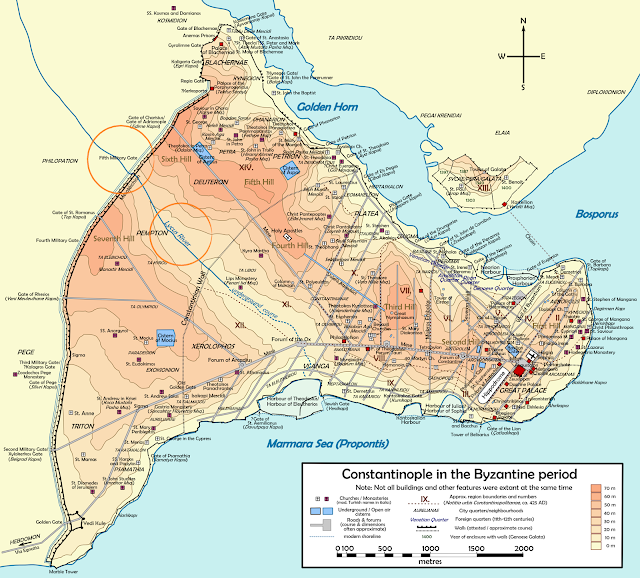Fifth Military Gate Along the Walls of Theodosius
When you walk along the Adnan Menderes Avenue named after the toppled political leader in the coup d'etait of 1960, you would be following the course of the river Lycus in antiquity. The avenue intersects the Walls of Theodosius that stretch across the historical peninsula from the Golden Horn to the Marmara Sea. You would remember Emperor Theodosius, the one who erected the obelisk in the hippodrome.
We followed the road half a kilometer north along the walls to reach a formidable gate, the frame seeming to be made out of marble. It was the "Fifth Military Gate" , nowadays named after the neighborhood of Sulukule nearby where one of the oldest communities of the city used to reside, the Gypsies. They were permitted to stay within the walls in late 13th century Byzantium. The towns people were warned to beware of gypsy fortune tellers, magicians, bear leaders who keep on engaging with their activities to this day.
The gate is also called Hücumkapısı in Turkish which is a reminder of the major assault where Constantine XI Drageses commanded the troops until he was last seen before the walls on the morning of May 29, 1453.
Maybe Mehmed the Conqueror and Constantine, they have both seen each other's figure across the battle field. Mehmed would be just outside of his tent riding his horse to the front urging his men to fight hearty and Constantine was encouraging his men to give a fight to the inevitable end.
Parts of the walls still stand intact as a testimony to once grandeur of the Byzantine Empire and the force that replaced it, making Mehmed the Conqueror claim himself Kaiser-i Rum, the Emperor of Rome.
We followed the road half a kilometer north along the walls to reach a formidable gate, the frame seeming to be made out of marble. It was the "Fifth Military Gate" , nowadays named after the neighborhood of Sulukule nearby where one of the oldest communities of the city used to reside, the Gypsies. They were permitted to stay within the walls in late 13th century Byzantium. The towns people were warned to beware of gypsy fortune tellers, magicians, bear leaders who keep on engaging with their activities to this day.
 |
| Fifth Military Gate, Sulukule Kapısı or Hücum Kapısı (Assault Gate) |
The gate is also called Hücumkapısı in Turkish which is a reminder of the major assault where Constantine XI Drageses commanded the troops until he was last seen before the walls on the morning of May 29, 1453.
 |
| Constantine was last seen on the walls around the Fifth Military Gate |
Parts of the walls still stand intact as a testimony to once grandeur of the Byzantine Empire and the force that replaced it, making Mehmed the Conqueror claim himself Kaiser-i Rum, the Emperor of Rome.





Comments
Post a Comment